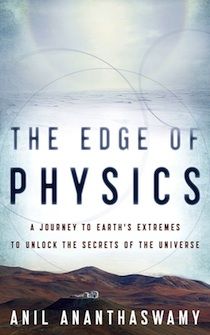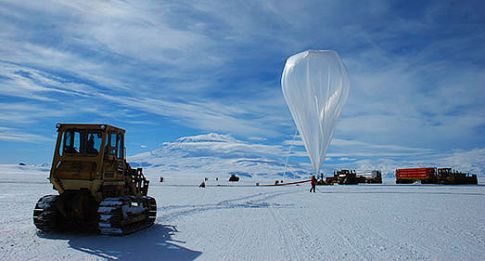On a recent trip to the LHC, I met with CERN's research director, Sergio Bertolucci, who urged me to visit the underground heart of the accelerator before the detectors were finally closed off for data-taking. The experience of seeing the vast machinery is something that can barely be described in words, he said: "It's magnificent, like standing within a cathedral."

I was reminded of Bertolucci's words while reading Anil Ananthaswamy's new book, "The Edge of Physics: A Journey to Earth's Extremes," which takes the reader to the far reaches of the globe to visit some of the most important physics and astronomy experiments running today. As well as searching for extra dimensions at the LHC, Ananthaswamy plunges down Minnesota's Soudan Mine to hunt for dark matter, travels to the frigidly cold Lake Baikal, in Russia, and Antarctica for hints about the nature of spacetime carried by cosmic neutrinos, and questions whether the cosmic microwave background could reveal that our universe is only one of many in a much larger multiverse.
The huge theoretical ideas that form the basis of the experiments discussed--including string theory, loop quantum gravity, supersymmetry and ideas on the origins of dark matter and dark energy--will be familiar to both members of FQXi and readers of this site. Indeed, Ananthaswamy chats to FQXi's Alan Guth, Brian Greene and Andrei Linde, as well as many other renowned physicists, to flesh out exactly what is at stake in terms of our understanding of the universe. But this is not a book for those looking for a beginner's guide to theoretical physics; Ananthaswamy delivers only as much theory as is needed to carry you along his journey with him.
Instead, the book celebrates the awe-inspiring nature of these experiments in their own right and the technological ingenuity needed to build some of the world's largest telescopes and most complex apparatus. I had somewhat cynically thought that I had heard everything there was to hear about the impressive size of the LHC; however, Ananthaswamy managed to surprise me with a truly jaw-dropping fact: So much rock has been gouged out of the ground to make way for the LHC's ATLAS detector (300,000 tons) that the hole left behind that houses the detector forms a low-density "bubble" within the Earth--and this bubble, along with the ATLAS experiment, is floating upwards by 0.2 millimeters each year. Reading facts such as these should humble any theoretical physicist waiting for validation of their ideas.
But the book is more than a list of technological feats; it's the story of the unsung heroes behind the experiments. Ananthaswamy is on a personal quest to see how physicists, engineers and maintenance staff survive in some of the most inhospitable locations in the world and why they choose to dedicate their lives to keeping these behemoths running. The most engaging episodes in the book involve Ananthaswamy facing his fears as he precariously crosses the frozen ice of Lake Baikal, is plunged into the depths of the Soudan Mine in complete darkness, and even digs a "coffin-like" trench in the Antarctic ice and attempts to sleep in it, before being overcome by "claustrophic panic." Perhaps the best compliment I can give the book is that Ananthaswamy's vivid descriptions of his escapades had me alternately laughing and gasping with anxiety.

In contrast to the sense of peril such icy locations may afford, Ananthaswamy also conveys the warmth of the communities they house as he describes, for instance, the drinking rituals on Lake Baikal (leading to him unexpectedly break into a song from one of my favourite classic Bollywood films with some Russian physicists). My only complaint is that at times I wished that the book contained photographs showing these inspiring people and exotic places. Ananthaswamy is a former colleague of mine from New Scientist magazine and I recall him returning from his travels to McMurdo ice station with some fantastic images of the launch of a balloon that will look for signs of antimatter (pictured), and photos such as these would have enriched the book.
Nonetheless, the book captures the essence of why people sacrifice home comforts to spend prolonged lengths of time in isolated regions, pursuing answers about the nature of reality. It's no coincidence that the narrative is bookended by visits to monasteries, the first Benedictine, the second Buddhist. FQXi's Linde discusses how such traditions could--even unwittingly--shape a physicist's scientific worldview (or universe-view), for instance, creating prejudice towards the idea of a multiverse. "The standard monotheistic tradition tells you that there is one God, one universe, and one set of laws. 'And [God says] if you do not obey me, if you do not believe in me, then I'll punish you and all your relatives'," Linde is quoted as saying. It's a point that is worth further thought: Are some aspects of theoretical physics more in line with Eastern rather than Western philosophy? Neither? Both? Or should the issue that Linde raises be irrelevant because pushing the boundaries of physics should be an objective enterprise separate from personal philosophy?
If nothing else, Ananthaswamy is to be commended for highlighting a fact that is often overlooked in the narrative of physics told in popular science books: Those aspiring to answer foundational questions about the universe must thank explorers such as Amundsen, Scott and Shackleton for opening up the furthest extremes of the planet to test ideas that lie at the edge of physics.
"The Edge of Physics" is already on sale in the United States (here) and will be available in the UK from Thursday (here).